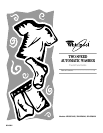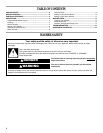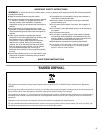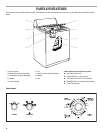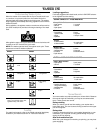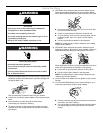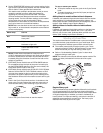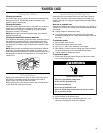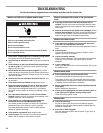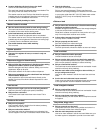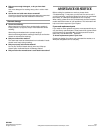
11
■ Is water deflecting off the tub ring or the load?
Center the tub before starting the washer.
The wash load should be balanced and not overloaded. The
fill or spray rinses can deflect off the load.
The washer must be level. The front feet should be properly
installed and the nuts tightened. Reset the rear leveling legs
(if needed). See the Installation Instructions.
■ Check household plumbing for leaks.
Washer basket is crooked
■ Was the washer basket pulled forward during loading?
The wash load should be balanced and not overloaded. Push
the basket to the center before starting wash.
■ Is the load balanced, and is the washer level?
The wash load should be balanced and not overloaded.
The washer must be level. The front feet should be properly
installed and the nuts tightened. Reset the rear leveling legs
(if needed). See the Installation Instructions.
■ The washer basket moves while washing.
This is normal.
Agitator operation
■ The top of the agitator is loose, or moves in only one
direction.
This is normal.
Dispensers clogged or bleach leaking
■ Did you follow the manufacturer’s directions when adding
detergent and fabric softener to the dispensers?
Measure detergent and fabric softener. Slowly pour into the
dispensers. Wipe up all spills.
Dilute fabric softener in the fabric softener dispenser.
■ Did you put powdered or color-safe bleach into the liquid
chlorine bleach dispenser?
Add powdered or liquid color-safe bleach directly to the
basket. Do not use the chlorine bleach dispenser for color-
safe bleach.
Load too wet
■ Did you use the right cycle for the load being washed?
Select a cycle with a higher spin speed (if available).
■ Did you use a cold rinse?
Cold rinses leave loads wetter than warm rinses. This is
normal.
Residue or lint on load
■ Did you sort properly?
Sort lint givers (towels, chenille) from lint takers (corduroy,
synthetics). Also sort by color.
■ Did you overload the washer?
The wash load must be balanced and not overloaded. Lint
can be trapped in the load if overloaded. Wash smaller loads.
■ Check the following:
Was paper or tissue left in the pockets?
Did you use enough detergent? Follow manufacturer’s
directions. Use enough detergent to hold the lint in the water.
Is your water colder than 60°F(15.6°C)? Wash water colder
than 60°F (15.6°C) may not completely dissolve the
detergent.
Stains on load
■ Did you follow the manufacturer’s directions when adding
detergent and fabric softener?
Measure detergent and fabric softener. Use enough detergent
to remove soil and hold it in suspension.
Dilute fabric softener and add to the rinse portion of a cycle
only. Do not drip fabric softener onto clothes.
■ Is there above average iron (rust) in water?
You may need to install an iron filter.
■ Did you properly sort the load?
Sort dark clothes from whites and lights.
■ Did you unload the washer promptly?
To avoid dye transfer, unload the washer as soon as it stops.
Load is wrinkled
■ Did you unload the washer promptly?
Unload the washer as soon as it stops.
■ Did you use the right cycle for the load being washed?
Use the Synthetics/Permanent Press cycle or another cycle
with low spin speeds (if available) to reduce wrinkling.
■ Did you overload the washer?
The wash load must be balanced and not overloaded. Loads
should move freely during washing.
■ Was the wash water warm enough to relax wrinkles, or
are you using warm rinses?
Use hot or warm washes if safe for the load. Use cold rinse
water.
■ Are the hot and cold water hoses reversed?
Check to be sure the hot and cold water hoses are connected
to the right faucets. See the Installation Instructions.
Load is tangled or twisted
■ Did you overload the washer?
The wash load must be balanced and not overloaded. Loads
should move freely during washing.
■ Did you wrap items around the agitator?
Drop items loosely into the washer. Do not wrap items around
the agitator.
Gray whites, dingy colors
■ Did you properly sort the load?
Dye transfer can occur when mixing whites and colors in a
load. Sort dark clothes from whites and lights.
■ Was the wash temperature too low?
Use hot or warm washes if safe for the load. Make sure your
hot water system is adequate to provide a hot water wash.



